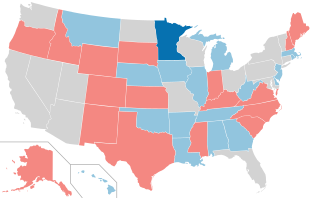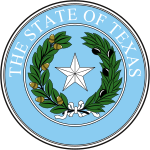
The 1990 United States Senate elections were held on Tuesday, November 6, 1990, with the 33 seats of Class 2 contested in regular elections. Special elections were also held to fill vacancies. The Democratic Party increased its majority with a net gain of one seat from the Republican Party. The election cycle took place in the middle of President George H. W. Bush's term, and as with most other midterm elections, the party not holding the presidency gained seats in Congress. This was the first time since 1980 that any party successfully defended all their own seats, and the first time Democrats did so since 1958.

The 1988 United States Senate elections were elections for the United States Senate. Held on November 8, 1988, the 33 seats of Class 1 were contested in regular elections. In spite of the Republican victory by George H. W. Bush in the presidential election, the Democrats gained a net of 1 seat in the Senate. 7 seats changed parties, with 4 incumbents being defeated. The Democratic majority in the Senate increased by one to 55–45.

The 1986 United States Senate elections were elections for the United States Senate. Held on November 4, in the middle of Ronald Reagan's second presidential term, the 34 seats of Class 3 were contested in regular elections. The Republicans had to defend an unusually large number of freshman Senate incumbents who had been elected on President Ronald Reagan's coattails in 1980. Democrats won a net of eight seats, defeating seven freshman incumbents, picking up two Republican-held open seats, and regaining control of the Senate for the first time since January 1981. This remains the most recent midterm election cycle in which the sitting president's party suffered net losses while still flipping a Senate seat.

The 1984 United States Senate elections were held on November 6, with the 33 seats of Class 2 contested in regular elections. They coincided with the landslide re-election of President Ronald Reagan in the presidential election. In spite of the lopsided presidential race, Reagan's Republican Party suffered a net loss of two Senate seats to the Democrats, although it retained control of the Senate with a reduced 53–47 majority.

The 1978 United States Senate elections were held on November 7, in the middle of Democratic President Jimmy Carter's term. The 33 seats of Class 2 were contested in regular elections. Special elections were also held to fill vacancies.

The 1976 United States Senate elections was an election for the United States Senate. Held on November 2, the 33 seats of Class 1 were contested in regular elections. They coincided with Democrat Jimmy Carter's presidential election and the United States Bicentennial celebration. Although almost half of the seats decided in this election changed parties, Carter's narrow victory did not provide coattails for the Democratic Party. Each party flipped seven Senate seats, although, one of the seats flipped by Democrats was previously held by a Conservative.

The 1952 United States Senate elections was an election for the United States Senate which coincided with the election of Dwight D. Eisenhower to the presidency by a large margin. The 32 Senate seats of Class 1 were contested in regular elections, and three special elections were held to fill vacancies. The Republicans took control of the Senate by managing to make a net gain of two seats. However, Wayne Morse (R-OR) became an independent forcing Republicans to rely on Vice President Richard Nixon's tie-breaking vote, although Republicans maintained a 48–47–1 plurality. Wayne Morse would caucus with the Republicans at the start of Congress’ second session on January 6, 1954 to allow the GOP to remain in control of the Senate. This was the third time, as well as second consecutive, in which a sitting Senate leader lost his seat.

The 1916 United States Senate elections were elections that coincided with the re-election of President Woodrow Wilson. This was the first election since the enactment of the Seventeenth Amendment that all 32 Class 1 senators were selected by direct or popular elections instead of state legislatures. Republicans gained a net of two seats from the Democrats, and then an additional two seats through mid-term vacancies thereby reducing Democrats to a 52–44 majority.

The 1974 Texas gubernatorial election was held on November 5, 1974, to elect the governor of Texas. Incumbent Democratic governor Dolph Briscoe was easily re-elected to a second term, winning 61% of the vote to the 31% of Republican Jim Granberry, the former mayor of Lubbock. Raza Unida candidate Ramsey Muniz won 6%, while the remaining 2% were cast for other candidates.

Randall Keith Weber is an American businessman and politician who has represented Texas's 14th congressional district in the United States House of Representatives since 2013. He was previously a member of the Texas House of Representatives, representing the 29th district. He is a member of the Republican Party.

The 1970 United States Senate election in Texas was held on November 3, 1970. Incumbent Democratic U.S. Senator Ralph Yarborough was defeated by former U.S. Representative Lloyd Bentsen in the Democratic primary. Bentsen then defeated Republican U.S. Representative and future president George H. W. Bush in the general election. When Bush was running for president in 1988, his Democratic opponent, Massachusetts Governor Michael Dukakis, selected Bentsen as his vice presidential running mate.

The 1942 United States Senate election in Texas was held on November 3, 1942. Incumbent Democratic U.S. Senator W. Lee "Pappy" O'Daniel was re-elected to a second term.

The 1916 United States Senate election in Texas was held on November 7, 1916. Incumbent Democratic U.S. Senator Charles Culberson was re-elected to a fourth term in office. Culberson survived a challenge from former Governor Oscar Colquitt in the Democratic primary, then easily won the general election. He was challenged by Republican Alex W. Atcheson and Socialist Thomas Hickey, publisher of The Rebel.

The 1928 United States Senate election in Texas was held on November 6, 1928. Incumbent Democratic U.S. Senator Earle Mayfield ran for re-election to a second term.
Democrat William Proxmire won a special election to fill the vacancy created by the death of Senator Joseph R. McCarthy (R-WI). Also, Price Daniel (D-TX) left the Senate to become governor of Texas, and Democrat Ralph Yarborough won a special election for that Senate seat. The Democrats thus made a net gain of one seat. However, Congress was out of session at the time of the Democratic gain in Wisconsin, and the Republicans gained a Democratic-held seat only weeks after the next session started, when Republican John D. Hoblitzell Jr. was appointed to fill the vacancy created by the death of Senator Matthew M. Neely (D-WV).

The 1922 Texas gubernatorial election was held on 7 November 1922 in order to elect the Governor of Texas. Incumbent Democratic Governor Pat Morris Neff won re-election to a second term, defeating Republican candidate William Hawley Atwell in a landslide.

The 1918 Texas gubernatorial election was held on November 5, 1918, in order to elect the Governor of Texas. Incumbent Democratic governor William Pettus Hobby easily won re-election to his first full term after ascending to the governorship in 1917 upon the impeachment and conviction of his predecessor, governor James "Pa" Ferguson. He defeated Republican nominee Charles Albert Boynton.

The 1916 Texas gubernatorial election was held on November 7, 1916, in order to elect the Governor of Texas. Incumbent Democratic governor James E. "Pa" Ferguson easily won re-election to a second term, defeating his Republican challenger, Rentfro Creager.

The 1914 Texas gubernatorial election was held on November 3, 1914, in order to elect the Governor of Texas. James E. Ferguson, nominated by the Democratic Party, easily defeated his two general election opponents, E.R. Meitzen of the Socialist Party and John W. Philip of the Republican Party.

The 1910 Texas gubernatorial election was held on November 8, 1910, in order to elect the Governor of Texas. Democrat Oscar Branch Colquitt, a member of the Texas Railroad Commission, won re-election to his first term as Governor of Texas.






















